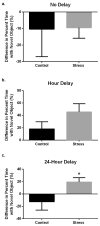Two weeks of predatory stress induces anxiety-like behavior with co-morbid depressive-like behavior in adult male mice
- PMID: 25200517
- PMCID: PMC5688846
- DOI: 10.1016/j.bbr.2014.08.060
Two weeks of predatory stress induces anxiety-like behavior with co-morbid depressive-like behavior in adult male mice
Abstract
Psychological stress can have devastating and lasting effects on a variety of behaviors, especially those associated with mental illnesses such as anxiety and depression. Animal models of chronic stress are frequently used to elucidate the mechanisms underlying the relationship between stress and mental health disorders and to develop improved treatment options. The current study expands upon a novel chronic stress paradigm for mice: predatory stress. The predatory stress model incorporates the natural predator-prey relationship that exists among rats and mice and allows for greater interaction between the animals, in turn increasing the extent of the stressful experience. In this study, we evaluated the behavioral effects of exposure to 15 days of predatory stress on an array of behavioral indices. Up to 2 weeks after the end of stress, adult male mice showed an increase of anxiety-like behaviors as measured by the open field and social interaction tests. Animals also expressed an increase in depressive-like behavior in the sucrose preference test. Notably, performance on the novel object recognition task, a memory test, improved after predatory stress. Taken as a whole, our results indicate that 15 exposures to this innovative predatory stress paradigm are sufficient to elicit robust anxiety-like behaviors with evidence of co-morbid depressive-like behavior, as well as changes in cognitive behavior in male mice.
Keywords: Anxiety-like behavior; Depressive-like behavior; Mice; Predatory stress.
Copyright © 2014 Elsevier B.V. All rights reserved.
Figures



Similar articles
-
Psychological stress in adolescent and adult mice increases neuroinflammation and attenuates the response to LPS challenge.J Neuroinflammation. 2012 Jan 16;9:9. doi: 10.1186/1742-2094-9-9. J Neuroinflammation. 2012. PMID: 22248083 Free PMC article.
-
Juvenile stress induces a predisposition to either anxiety or depressive-like symptoms following stress in adulthood.Eur Neuropsychopharmacol. 2007 Mar;17(4):245-56. doi: 10.1016/j.euroneuro.2006.06.007. Epub 2006 Aug 2. Eur Neuropsychopharmacol. 2007. PMID: 16889944
-
Sex differences and phase of light cycle modify chronic stress effects on anxiety and depressive-like behavior.Behav Brain Res. 2011 Sep 12;222(1):212-22. doi: 10.1016/j.bbr.2011.03.038. Epub 2011 Mar 31. Behav Brain Res. 2011. PMID: 21440009
-
Predatory stress as an experimental strategy to measure fear and anxiety-related behaviors in non-human primates.Rev Neurosci. 2008;19(2-3):157-69. doi: 10.1515/revneuro.2008.19.2-3.157. Rev Neurosci. 2008. PMID: 18751522 Review.
-
Sex differences in anxiety and depression: insights from adult rodent models of chronic stress and neural plasticity.Front Behav Neurosci. 2025 May 14;19:1591973. doi: 10.3389/fnbeh.2025.1591973. eCollection 2025. Front Behav Neurosci. 2025. PMID: 40438297 Free PMC article. Review.
Cited by
-
Inducible and Conditional Stimulation of Adult Hippocampal Neurogenesis Rescues Cadmium-Induced Impairments of Adult Hippocampal Neurogenesis and Hippocampus-Dependent Memory in Mice.Toxicol Sci. 2020 Sep 1;177(1):263-280. doi: 10.1093/toxsci/kfaa104. Toxicol Sci. 2020. PMID: 32617577 Free PMC article.
-
Enhanced aggressive behaviour in a mouse model of depression.Neurotox Res. 2015 Feb;27(2):129-42. doi: 10.1007/s12640-014-9498-4. Epub 2014 Nov 4. Neurotox Res. 2015. PMID: 25367807
-
Feasibility of focal cerebral ischemia and reperfusion surgery combined with chronic unpredictable mild stress to simulate the post-stroke depressive state in rats.Behav Brain Funct. 2015 Dec 24;11:39. doi: 10.1186/s12993-015-0085-5. Behav Brain Funct. 2015. PMID: 26704068 Free PMC article.
-
Predator stress-induced depression is associated with inhibition of hippocampal neurogenesis in adult male mice.Neural Regen Res. 2019 Feb;14(2):298-305. doi: 10.4103/1673-5374.244792. Neural Regen Res. 2019. PMID: 30531013 Free PMC article.
-
Shaping behaviors through social experience and their proposed sensitivity to stress.Learn Mem. 2024 Dec 16;31(12):a053926. doi: 10.1101/lm.053926.124. Print 2024 Dec. Learn Mem. 2024. PMID: 39681461 Review.
References
-
- Narrow WE, Rae DS, Robins LN, Regier DA. Revised prevalence estimates of mental disorders in the United States: using a clinical significance criterion to reconcile 2 surveys’ estimates. Arch Gen Psychiatry. 2002;59:115–23. - PubMed
-
- Ravindran AV, Griffiths J, Waddell C, Anisman H. Stressful life events and coping styles in relation to dysthymia and major depressive disorder: variations associated with alleviation of symptoms following pharmacotherapy. Prog Neuropsychopharmacol Biol Psychiatry. 1995;19:637–53. - PubMed
-
- Dura JR, Stukenberg KW, Kiecolt-Glaser JK. Chronic stress and depressive disorders in older adults. J Abnormal Psychol. 1990;99:284–90. - PubMed
-
- Pynoos RS, Steinberg AM, Piacentini JC. A developmental psychopathology model of childhood traumatic stress and intersection with anxiety disorders. Biol Psychiatry. 1999;46:1542–54. - PubMed
-
- Vyas A, Pillai AG, Chattarji S. Recovery after chronic stress fails to reverse amygdaloid neuronal hypertrophy and enhanced anxiety-like behavior. Neuroscience. 2004;128:667–73. - PubMed
Publication types
MeSH terms
Substances
Grants and funding
LinkOut - more resources
Full Text Sources
Other Literature Sources
Medical

